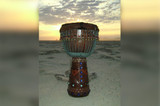Djembe, Cajon, Bongos or Congas?
Once you have decided that hand drums are something you would like to learn to play, it may be difficult to choose a particular type. One of the great things about these percussion instruments is that there are so many to choose from. That is also what can make it difficult to decide. Four popular choices for beginning drummers, or for those looking for a different depth of sound or ease of portability as a drummer are the djembe, cajon, bongos, or congas. These drums are all popular instruments with specific sounds and some lend themselves to a variety of music genres more easily than others. Let’s look at each and see what it has to offer the drummer who finds confusion in the search.
Djembe
Djembes are usually what people envision when they think of African drumming. Although there are, in fact, a wide variety of traditional African drums, the djembe has garnered plenty of love throughout the world. And, it is understandable, because the djembe offers a satisfying drumming experience that seems to hit people right at the core. The djembe is traditionally a goblet-shaped, tunable drum with an animal skin head. These days, we are seeing modern interpretations of the drum that are different in shape and materials, making them easier to store and transport while offering the deep, rich sounds for which djembes are known.
Cajon
The cajon is rapidly becoming a world-wide favorite as many people enjoy its versatility and ease of play. These days, if you ask if you should learn the djembe, cajon, bongos, or congas, you may very well hear a resounding, “Cajon!” The drum is fun and easy to learn and is easily customized to suit the desires of the drummer. It is also easy to make, so many drummers are trying their hands at construction. Cajons have their roots in Afro-Peruvian history and began life as simple crates turned drums. Now, the selection of cajons available is spectacular for both sight and sound.
Bongos
Bongos are an Afro-Cuban drum where two drums become one. A large and small drum are connected to one another and are easy to transport due to their size. The drums may have tack-heads or be tunable, offering more of a variety than many expect. These drums are usually played by hand, but some may use sticks in certain situations. Bongos generally produce a high pitched sound, versus the deep tones of the djembe and are played while seated or placed on stands.
Congas
When deciding among the wide range of choices in hand drums, the congas definitely have qualities that speak for them. Congas are typically played in groups of two or three, and it is not uncommon to see Latin percussionists play congas and bongos in the same drum set up. They are the foundational drum for most Cuban music and can be played either sitting or standing. If you love Latin music, learning to play the congas can be a perfect fit for such an incredible range of sound.
Whether you are a fan of the djembe, crazy for cajons, like to beat on bongos or can't get enough congas, there is no right choice when it comes to which hand drum will fit your needs best. Of course, with so many drumming influences and styles from which to choose, you may find yourself learning to play them all.
Recent Posts
-
What is the Best Size Djembe for Beginners?
If you're new to the world of percussion and interested in learning the djembe, you're in for a t …16th Jul 2024 -
The Benefits of Becoming a Drumming Teacher: Transforming Passion into Profession
Why become a drumming teacher? Becoming a drumming teacher is an excellent way to share your pas …22nd May 2024 -
What Makes the Djembe Drum a Spiritual Instrument in African Music?
Origin and history of the Djembe drum The Djembe drum originates from West Africa and holds sign …16th May 2024




